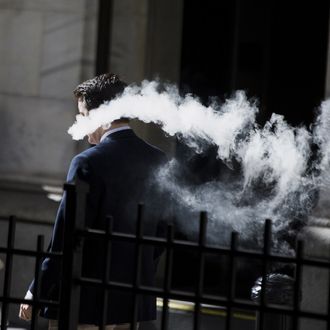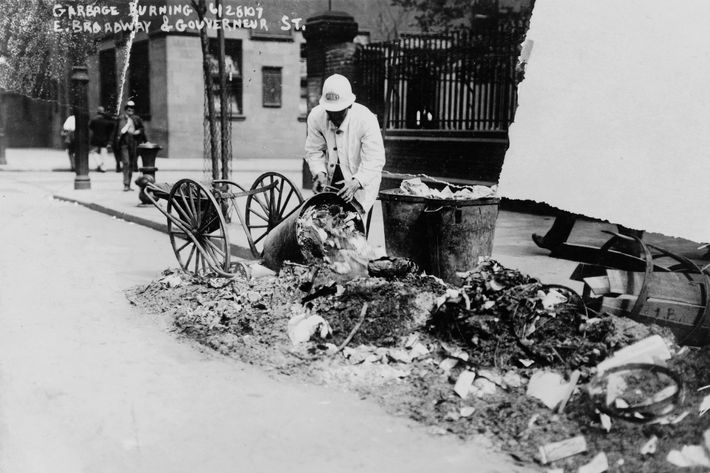
Summertime, and the city is stinky. Trash bags ooze, urine coats subway platforms, and the scent of frying kebabs curls among the skyscrapers. The warm-weather assault on New Yorkers’ noses has taken place every year since New Amsterdam days, but its specific qualities keep changing. These days, the funky tang of marijuana has become as ubiquitous as cigarette smoke once was — surely a sign that city life is improving. Instead of curling from private homes with a frisson of defiance, pot smoke now permeates the atmosphere with such nonchalance that it barely rates a suspicious sniff. For New Yorkers of a certain age, that odor has specific outdoor associations: bongo circles in Washington Square, dealers ducking into Central Park at Columbus Circle to retrieve nickel bags stashed in a tree, smoke and mellow chatter wafting from a fire escape on the Lower East Side. I loathe the bitter, high-strung reek of tobacco that even today clouds the sidewalk outside of concert halls at intermission. Marijuana is more seductive, and I keep hoping that as pot’s turf spreads, its scent will, um, blunt the city’s rage. I sniff tolerance. This is the scent of change, the odor of our times.
You can trace a social history of the city through its evolving smells. Two years ago, the San Francisco gallery SPUR mounted “Urban Olfactory,” a bracing historical tour that included eau de New Jersey Turnpike. The show could have chosen a more endearing representative of the metro area: burnt sugar, say. In the summer of 2014, Kara Walker installed her monumental sugar sphinx in one of the Domino plant’s doomed buildings on the Williamsburg waterfront. The room’s caramel air evoked an era in which sugar powered New York’s economy and sweetened entire neighborhoods, even as it embittered the lives of Caribbean slaves. In 1877, a reporter for Harper’s Monthly explored the waterfront warehouses where dockworkers stashed arriving cargo, and discovered there the cloying aromas of global trade. “Cross the threshold and climb the stairways from one low-roofed loft to another, and you wander among foreign fields and breathe the airs of every zone. Here are tier upon tier of hogsheads of sugar, perspiring molasses with the memory of the Cuban sun, and other hogsheads of old rum from Jamaica, beneath which the ground is greedily drinking precious oozings.” Today sweetness is a less potent element in the panorama of New York fragrances, though we do occasionally get the suggestion of maple syrup that drifts over from the sweet-scented Garden State.
To deodorant-raised Americans, summer can feel like a chemical or biological attack. A two-block walk yields a spray of ammonia sluiced onto the sidewalk from a restaurant kitchen, a blast of exhaust from a bus, a plume of starchy toxins from a dry cleaner, and a whiff of too much cologne. But when you find yourself objecting to any of these artifacts of the good life, it might help to reflect that, compared to the past, today’s city practically coddles our noses. Horrific stink has always accompanied rapid urbanization. As the city ballooned in the 19th century it pumped out an impressive range of gases that, on warm sunny days, gathered into a putrid miasma. Long before food trucks dispensed gourmet pho, vendors peddled oysters from carts, and by sunset the briny, metallic bouquet had … matured.
Certain neighborhoods had their own distinctive smell: Shipyards mixed freshly sawed lumber and bubbling pitch; the slaughterhouses of the East 50s released the fetor of pigs’ blood and offal; beer gardens gave Yorkville a yeasty redolence; and the Hudson River flatlands reeked of the horse carcasses that were dumped amid construction rubble. Blanketing all of these local variations was the ever-present hum of feces. In the days before a sewer system, it took a finely tuned nose to detect the notes of oil smoke and banana oil beneath the street symphony of human excrement and horse manure.

The city kept trying to exile the most offensive industries to relatively remote zones. In 17th-century New Amsterdam, the authorities banished tanneries to industrial suburbs, and around 1870 the Board of Health mapped “odor-producing industries,” many of which clustered along Brooklyn’s waterways. On some days, though, the wind defeated these attempts at segregation. Even a light breeze could blow noxious fetors into residential districts, prompting the Smell Committees to swing into action. These were posses of sensitive-schnozzed citizens who hunted down the sources of airborne pollutants. In The Ripple Effect, a 2011 book on industrial pollution, Alex Prud’homme describes one such sniffing mission up Newtown Creek, which took place in 1891.
As they worked upstream, around manure scows and cargo ships, they noticed mysterious liquids pouring from factories and saw signs that fertilizer companies were dumping their waste directly into the waterway. Passing the dog pound and sausage factories, they were revolted to see heaps of flesh baking in the open sun. Sludge acid, a tarlike substance produced by refineries, emitted an odor that could “nauseate a horse.” The smell grew worse and worse, until they reached the refineries themselves, “where the stenches began asserting themselves with all the vigor of fully developed stenches.”
Remember that account the next time you grumble about a puff of public pot or a whiff of lingering dog pee.






























